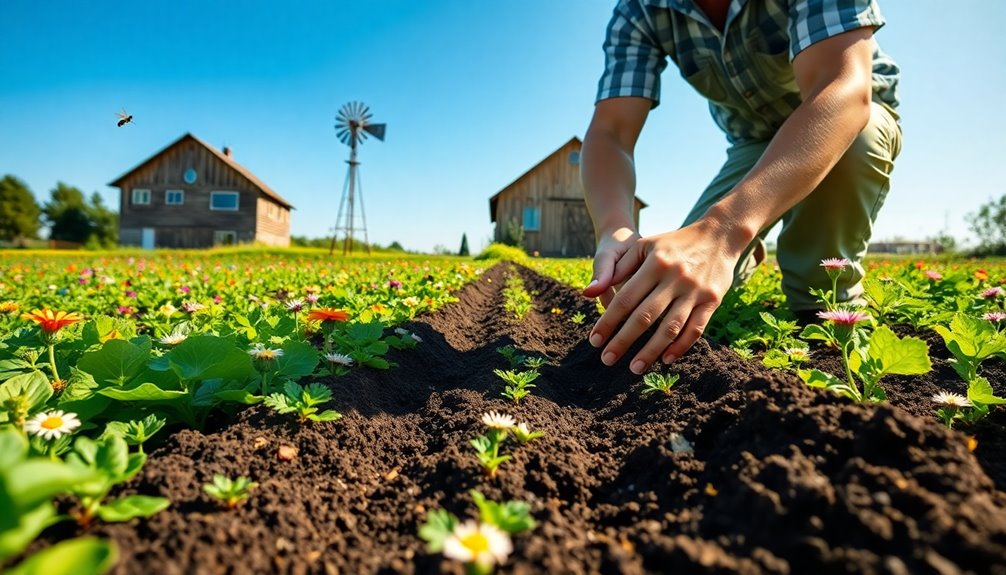Terrace farming's an innovative technique that transforms steep hills into flat surfaces for growing crops. By creating steps or terraces, it controls water runoff and prevents soil erosion, making difficult landscapes arable. This practice originated with ancient civilizations like the Incas and has been adapted worldwide. It supports sustainable agriculture and enhances food security, but it also presents challenges like labor intensity and high construction costs. Stick around to discover more about its types and cultural significance!
Key Takeaways
- Terrace farming converts steep hills into flat surfaces, allowing for effective crop cultivation and preventing soil erosion.
- It originated with ancient civilizations like the Incas in the Andes and incorporates various techniques adapted to local environments.
- Different types of terracing, such as contour, bench, and raised-bed, cater to specific crops and slopes for optimal water management.
- This agricultural method enhances crop yields, supports sustainable practices, and fosters community engagement while facing challenges like high construction costs.
- Terrace farming has significant cultural and environmental impacts, promoting biodiversity and preserving traditional agricultural knowledge in affected communities.
Definition and Origins of Terrace Farming

Terrace farming is an innovative agricultural technique that transforms hilly landscapes into flat surfaces, making it possible to cultivate crops effectively. This method prevents soil erosion and controls water runoff, allowing you to farm efficiently on steep slopes.
Originating with the Inca civilization in the Andes, terrace farming has roots in ancient practices from Mesopotamia and the Hanging Gardens of Babylon. Over centuries, various cultures across Asia, Africa, and beyond adopted this technique, adapting it to their unique environments. Its historical significance is immense, supporting large populations in mountainous regions.
Today, UNESCO recognizes the Rice Terraces of the Philippine Cordilleras, highlighting the enduring legacy of this sustainable farming practice.
Types of Terracing
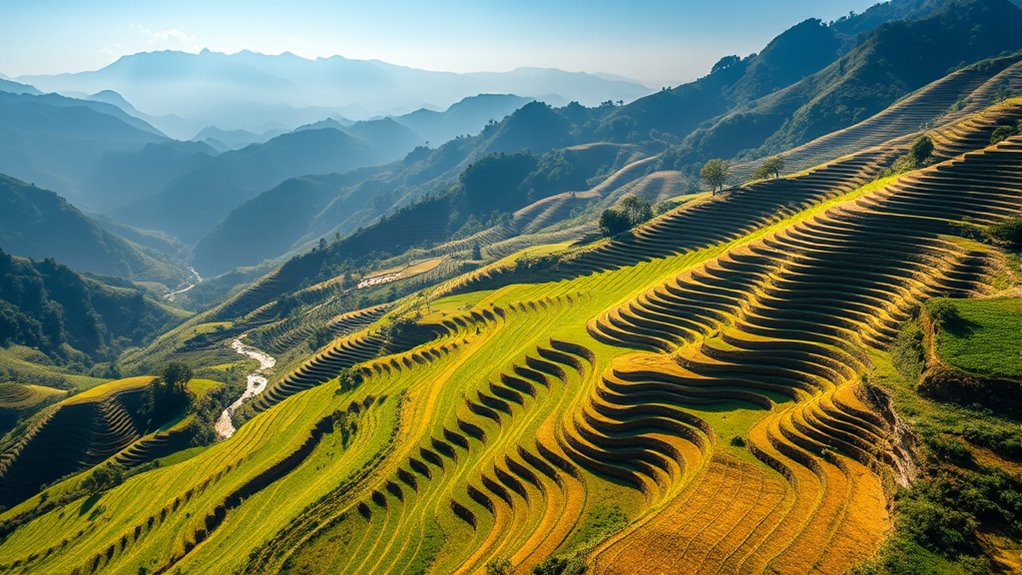
When exploring the various methods of terracing, you'll find that each type is tailored to specific landscape conditions and agricultural needs.
Contour farming, built along contour lines, prevents erosion and retains moisture but isn't ideal for steep slopes.
Bench terrace farming works well on steep hills, conserving water by slowly releasing it, though it demands significant labor.
Stepped terrace farming suits gentle slopes and effectively controls erosion, perfect for water-intensive crops like rice.
Raised-bed terrace farming enhances drainage and aeration, benefiting crops that require well-drained soil.
Regional variations exist, with unique practices in South America, the Philippines, Japan, and Africa, each adapting terracing to local crops and climates.
Advantages of Terrace Farming
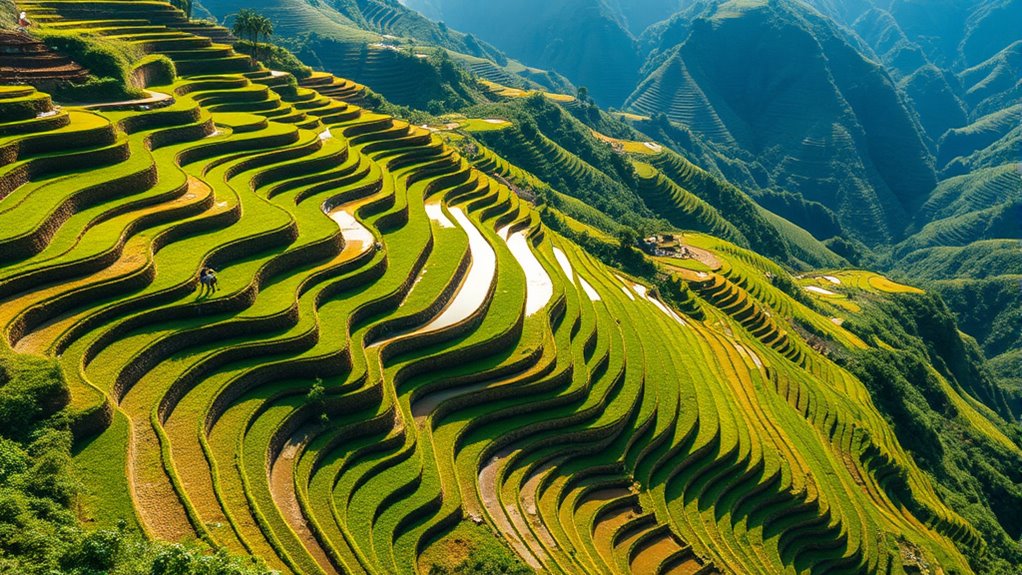
One major advantage of terrace farming is its ability to transform steep, unusable land into productive agricultural areas. By converting these slopes into arable land, you significantly increase the area available for cultivation.
This method not only improves crop yield through better water control and erosion reduction but also allows for diverse crop cultivation, from grains to herbs. You'll find that terracing maximizes land use efficiency, which directly contributes to enhanced food security by providing stable crop production.
Additionally, it plays a vital role in preventing soil erosion and conserving water, benefiting the environment. Ultimately, terrace farming supports sustainable agricultural practices while creating job opportunities, ensuring a brighter future for rural communities.
Challenges and Limitations

While terrace farming offers numerous benefits, it also faces significant challenges and limitations that can hinder its effectiveness.
You might encounter narrow, steep slopes that limit usable land and increase maintenance risks. The labor-intensive nature of building and maintaining terraces can strain resources, especially when machinery isn't practical.
Economic hurdles, like high construction costs and limited access to markets and inputs, can make it tough for smallholder farmers. Additionally, soil disturbance during terrace construction can lead to initial fertility decline and erosion risks.
Traditional practices may further slow your adaptation to modern techniques. Without proper training and knowledge, managing these challenges effectively can become overwhelming, impacting overall productivity and sustainability.
Cultural and Environmental Impact

Despite the challenges and limitations of terrace farming, its cultural and environmental impacts are profound.
You'll find that this ancient practice is deeply rooted in the identity of communities like the Atacameño and Quechua. Terraces serve as symbols of cultural heritage, showcasing traditional agricultural knowledge passed down through generations. They foster community engagement, ensuring equitable water distribution and social cohesion.
Environmentally, terracing effectively reduces soil erosion and conserves water, crucial in arid regions. By creating microclimates, terraces enhance biodiversity and improve local food security.
Additionally, these landscapes, recognized by UNESCO, highlight the harmonious relationship between humans and nature, emphasizing the importance of preserving both cultural practices and ecological balance.
Applications and Examples
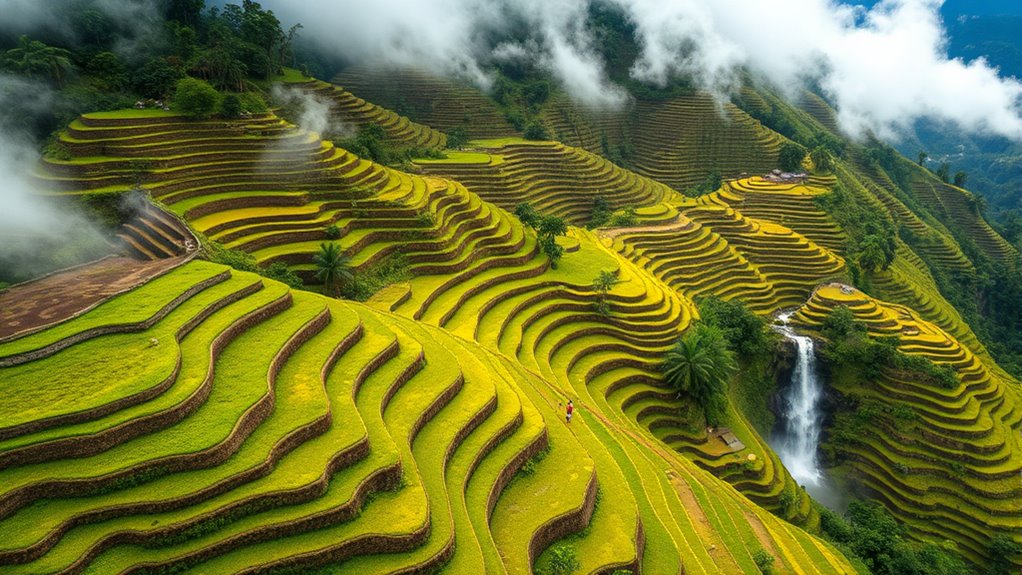
Terrace farming showcases a diverse range of applications that adapt to various environmental conditions and crop types. You can grow a wide variety of crops, from grains to vegetables and fruit trees, on these terraces.
Terrace farming adapts to diverse environments, enabling the cultivation of grains, vegetables, and fruit trees.
They help manage water effectively, acting as natural reservoirs that distribute water evenly across fields. Additionally, terracing prevents soil erosion by breaking slopes into manageable levels, which retains vital nutrients.
This method converts steep, unproductive land into arable fields, boosting food security by enhancing crop yields. Examples include rice terraces in Vietnam, Inca terraces in the Andes, and vineyards in Italy.
Each application demonstrates how terracing can transform landscapes, making them more productive and sustainable for farming.
Techniques for Effective Terrace Farming

Building on the diverse applications of terrace farming, understanding the techniques for effective terrace construction is key to maximizing its benefits.
Start with site evaluation—assess the slope, sunlight, and water drainage to determine suitability. Then, plan your terrace design, considering the number, width, and height based on your land's characteristics.
Soil preparation is crucial, so enrich it with organic matter to enhance fertility. Construct retaining walls using stones or wood to prevent erosion, and ensure proper drainage systems to avoid waterlogging.
Choose the right type of terracing, like bench or contour, depending on your needs. Finally, monitor your terraces regularly to maintain their effectiveness and adapt your crop selection to suit the conditions for optimal yields.
Historical Significance of Terrace Farming
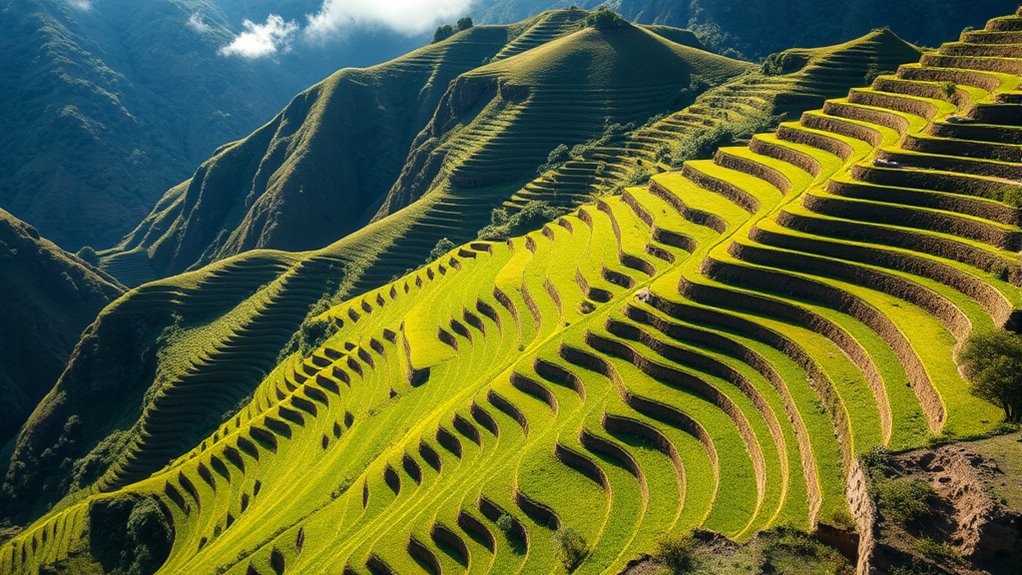
While many agricultural practices have evolved over time, terrace farming stands out for its historical significance and adaptability. You'll find its roots in ancient civilizations like the Incas and Mesopotamians, who transformed challenging terrains into productive landscapes.
This method spread globally, enhancing food security and economic stability in regions such as Asia, Africa, and South America. The Incas showcased remarkable engineering by building stone terraces without mortar, while the rice terraces of the Philippines highlight its cultural importance.
These agricultural innovations not only preserved cultural heritage but also adapted societies to harsh environments. Through community organization and labor, terrace farming played a vital role in supporting large populations, leaving a lasting legacy that continues to inspire today.
Future of Terrace Farming in Sustainable Agriculture
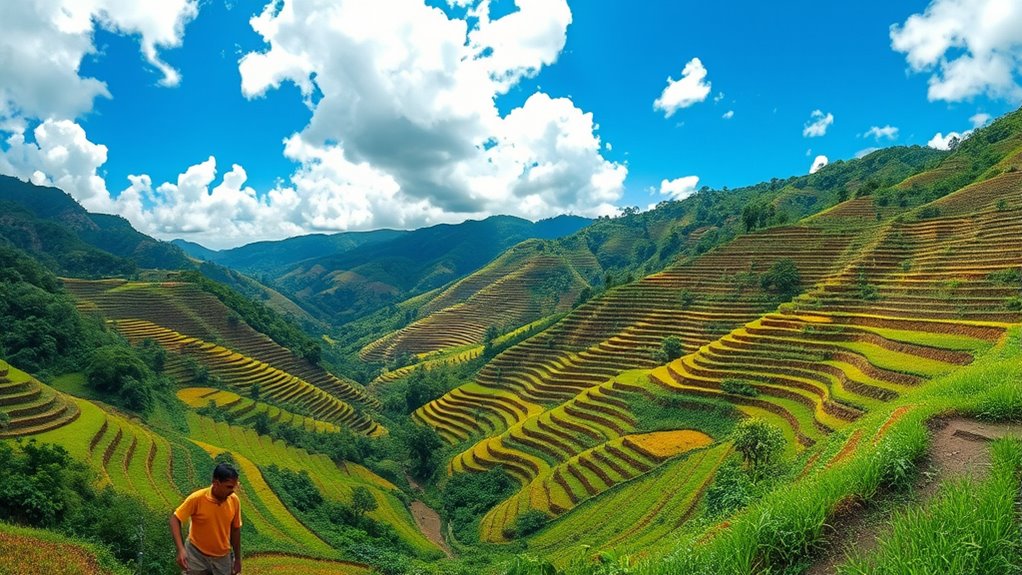
As the world faces escalating challenges like climate change and food insecurity, the future of terrace farming in sustainable agriculture looks promising.
By preventing soil erosion and conserving water, terracing enhances land use efficiency and boosts crop yields. Innovations like precision agriculture and robotics streamline processes, making farming more efficient and reducing costs. Additionally, integrating climate-resilient crops with terraced systems can optimize growth in diverse conditions, supporting renewable energy solutions that enhance farming sustainability. This approach not only supports biodiversity but also aligns with eco-friendly practices that promote sustainable land use. Furthermore, incorporating outdoor play into community farming initiatives can encourage social interaction and foster a stronger connection between people and their food sources.
As you embrace these advancements, you'll contribute to food security, job creation, and the overall stability of rural communities, paving the way for a more sustainable agricultural future.
Frequently Asked Questions
How Does Terrace Farming Impact Local Wildlife Populations?
Terrace farming impacts local wildlife populations by altering habitats and changing land use.
You might notice that some species adapt to the terraced landscapes, while others struggle due to habitat disruption.
By reducing soil erosion and improving water management, terracing can help maintain biodiversity, benefiting both wildlife and ecosystems.
However, it's essential to balance agricultural practices with conservation efforts to ensure that wildlife populations thrive alongside farming activities.
What Tools Are Commonly Used in Terrace Farming?
When you're diving into terrace farming, you'll want to equip yourself with essential tools.
You'll need garden hoes and spades for soil preparation, hand tillers for loosening tough soil, and rakes for leveling.
You'll also benefit from drip irrigation kits for efficient watering and seed planters for precise sowing.
Plus, don't forget protective gear to keep safe while you work.
With the right tools, you'll maximize your terrace farming success!
Can Terrace Farming Be Automated or Mechanized?
You can automate terrace farming, but it's challenging due to the labor-intensive nature and complex terrain.
Basic machinery like tractors may work on wider terraces, while specialized equipment can assist in planting and harvesting.
Drones and autonomous robots are emerging technologies that can monitor crops and perform tasks on steep lands.
Integrating IoT sensors and AI can enhance efficiency, but developing cost-effective solutions is crucial for broader adoption in these unique environments.
How Does Terrace Farming Affect Local Water Sources?
Terrace farming's impact on local water sources is nothing short of miraculous.
You'll notice how it reduces runoff, allowing more water to seep into the soil, which keeps your crops thriving. It also captures rainwater, minimizing the need for extra irrigation.
Plus, terraces help maintain water quality by reducing sedimentation and pollution. As a bonus, they recharge groundwater, ensuring a sustainable water supply for both farming and local ecosystems.
What Are the Economic Benefits of Terrace Farming for Farmers?
Terrace farming offers you significant economic benefits.
You'll see increased crop yields due to improved soil retention and water management, which boosts your productivity. By utilizing steep slopes, you maximize your land without harming ecosystems. This leads to higher incomes and diversified crops, reducing reliance on single crops.
Plus, modern technologies cut down on labor costs, making it easier for you to manage your farm efficiently and profitably.
Conclusion
In the dance between tradition and innovation, terrace farming stands as a testament to resilience. You harness the land's contours, turning steep slopes into fertile fields, while preserving the environment. The challenges may loom large, yet the rewards of sustainability shine brighter. As you cultivate these terraces, you're not just growing crops; you're nurturing a legacy. Embracing this ancient practice today fuels a sustainable future, marrying history with hope in the ever-evolving landscape of agriculture.






